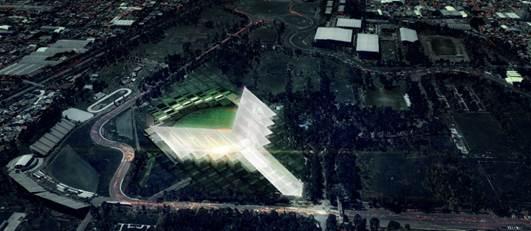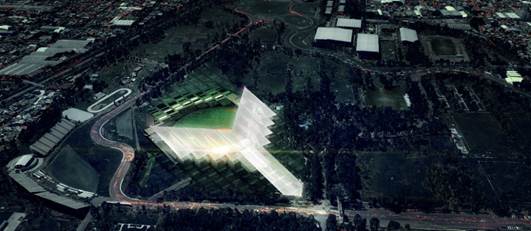
 After 16 championships and more than 70 years of history as the leading baseball team of Mexico, Los Diablos Rojos del Mexico will have a new home stadium, with an impressive 13,000+ covered seats and 3,000 berm seating, scheduled to open February 2017. Mr. Alfredo Harp Helú has commissioned Alonso de Garay (ADG) and Francisco Gonzalez-Pulido (Chief Designer, JAHN) to design the new stadium that will be located within the sports complex of Magdalena Mixhuca.
After 16 championships and more than 70 years of history as the leading baseball team of Mexico, Los Diablos Rojos del Mexico will have a new home stadium, with an impressive 13,000+ covered seats and 3,000 berm seating, scheduled to open February 2017. Mr. Alfredo Harp Helú has commissioned Alonso de Garay (ADG) and Francisco Gonzalez-Pulido (Chief Designer, JAHN) to design the new stadium that will be located within the sports complex of Magdalena Mixhuca.
Estadio Diablos will have a monumental lightweight roof structure resembling Diablos’ trident, which drastically contrasts the predictable roof geometry that has historically defined baseball stadiums around the world. Indicative of the sky, the roof design is sharp, translucent, luminous and dynamic. Composed of lightweight steel wrapped in PTFE textile material, the roof will become an iconic symbol for the great City of Mexico.
In contrast to the lightness of the roof, the base level is ceremonial and draws from many cultural cues. Designed using local materials from the Valley of Mexico and inspired by the pre-Hispanic era, the plaza level design has specific references to the court of the ancient
Mesoamerican ballgame and emphasizes the connection between the earth and the heavens.
“Our guiding concept was to establish the duality between prehispanic Mexico through the base and contemporary Mexico through the roof of Estadio Diablos which blends tradition, innovation, austerity and technology into one space,” stated Alonso de Garay of ADG.
The procession from Estadio Diablos’ grounds into the ballpark alludes to climbing an ancient Mesoamerican temple. As the spectator approaches the grand entrance, they are confronted with six truncated pyramids cladded in indigenous volcanic rock. Once inside, a ring connects all the seats and functions into one experience with unobstructed views to the field.
The key goal for Estadio Diablos is the vision of a great public space, where the open space is as important as the built space, which is a prominent architectural feature within Mexican culture. “Successful spaces must encourage strong social engagement, incorporate Mexican traditions and respect existing natural conditions.” stated Francisco Gonzalez-Pulido, Chief Designer of JAHN. Therefore the new stadium is seamlessly integrated to four major public spaces with very distinct characteristics.
The CIVIC PLAZA is the point of entry located to the north and signifies the great urban vestibule, where the procession into the stadium begins. The PUBLIC PLAZA is located at the southeast corner and designed to be accessible throughout the year. It will support the local community by providing an integrated approach to retail and cultural programs, such as the Hall of Fame of Diablos. The GREAT BERM is where the synthesis of Mexican tradition and spirit of baseball coexist, hosting 3000 spectators. The GARDENS, which are located at the southwest corner, preserve and foster the existing local plant species and provide seamless integration into the surrounding context.
Estadio Diablos aims to reduce energy consumption, waste and emissions. The design strives for a Net-Zero building using passive systems with minimal HVAC integration and active water reduction systems. This goal of sustainable design including minimal ecological impact sets a strong precedent for a new standard of building within Mexico.
Gonzalez-Pulido continues, “Estadio Diablos is more than a stadium, it is Mexico’s ballpark. Our challenge was to make the stadium a social and cultural center. As Estadio Azteca is the home of Mexican football, we strive for Estadio Diablos to become the home of Mexican baseball. Estadio Diablos is inclusive. It is a gift from Los Diablos Rojos to the Mexican people.”
The strategic alliance between Alonso de Garay and Francisco Gonzalez-Pulido provides a strategic balance between Mexican culture and advanced technology within the new stadium design.
ADG is an architecture studio based in Mexico City and lead by Alonso de Garay, founded under the principles of re-valorizing cities’ historic, cultural, artistic and social content, to generate new typologies that address the needs of contemporary societies. Museums, historic renovations, residential and office projects are among the firm’s most distinguished buildings.
JAHN is an international architectural firm headquartered in Chicago with offices in Germany, China and Qatar. Lead by Chief Designer Francisco Gonzalez-Pulido, a Mexican native, JAHN’s approach is based on the principals of integrated design, cultural and site-specific research and building solutions with clients. The firm’s core values are structured within three main notions: experiential architecture, evolutionary ideas, and extraordinary design.
JAHN’s recent project include Suvarnabhumi Airport in Bangkok, VEER Towers in Las Vegas, The Shanghai International Financial Center, Sony Center in Berlin and corporate headquarters of the Deutsche Post in Bonn, Germany recently awarded the 10-year performance award by the Council on Tall Buildings and Urban Habitat for its 85% reduction of energy consumption.
International team members include: JAHN Chief Designer Francisco Gonzalez-Pulido and his team: Sergio Valentini, Jon Gately, Sanaz Saeedi, Phil Stott, Joakim Wadenholt, Yuying Chen, Bryan Howard, Patrick Brown, Kun Liu, Joe Madon, Jacqueline Villa
ADG: Alonso de Garay, orge Guendulain, Alberto Cabrera, Carmen Cantú, Eduardo Lorenzana
Consultants: Populous: David Bower, Mike Sabatini, David Lizarraga, Werner Sobek: Roland Bechmann, Stephen Hagenmayer, Andreas Hoier, Thomas Winterstetter
For more information on the new Estadio Diablos, including interview or image requests, please contact Stephanie Pelzer, Executive Communications, spelzer@jahn-us.com, 312-374-2235.

There are no comments
Please login to post comments